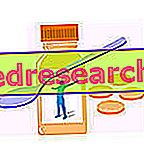Definition
As the word itself suggests, hyperprolactinemia is a clinical condition in which blood prolactin levels are higher than the normal range. Let us briefly recall that prolactin is a hormone secreted by the anterior pituitary gland which, by exerting its own function at the level of the breast, is implicated in lactation. The excessive production of prolactin leads to the plasma accumulation of the hormone (hyperprolactinemia, in fact), accompanied by galactorrhea and interruption of the menstrual cycle (amenorrhea).
Causes
Hyperprolactinemia may reflect a serious pathological condition; the exaggerated increase in prolactin levels in the blood can be favored by: taking medications (antidepressants, dopamine receptor antagonists, opiates, drugs for the treatment of angina, centrally acting antihypertensives - eg alpha-methyldopa, etc.), chronic renal failure, hypothyroidism, severe liver injury, microadenoma, radiotherapy, sarcoidosis, overtraining, pituitary tumor.
Symptoms
Among the most recurrent symptoms, growth retardation (delayed puberty) is a ubiquitous element in childhood hyperprolactinemia. In the female (adult) variant, instead, it is observed that 90% of the affected women complain of galactorrhea, oligomenorrhea, amenorrhea or other menstrual irregularities; to these symptoms, there is a drop in libido, infertility and hirsutism. In humans, hypeprolactinemia often causes erectile dysfunction.
Information on Hyperprolactinemia - Hyperprolactinemia Drugs is not intended to replace the direct relationship between health professional and patient. Always consult your doctor and / or specialist before taking Hyperprolactinaemia - Hyperprolactinemia Drugs.
drugs
The re-establishment of serum prolactin levels is the first goal to be achieved, easily obtainable in the milder forms: just think, for example, of the forms of hyperprolactinemia dependent on the administration of some drugs (it is sufficient to stop therapy and to take at the same time the intake of alternative active ingredients) or related to hypothyroidism (the intake of thyroid hormones is normally able to report prolactin values in the physiological ranges).
Different speech for hyperprolactinemia derived from adenomas and microadenomas: the treatment is obviously more delicate. However, it is important to underline the discrepancy between the hypotheses of therapists of some authors - convinced that the accumulation of prolactin in the blood can be resolved with a specific pharmacological treatment aimed at the destruction of microadenomas - and of others, who believe, instead, that the therapy more indicated both the expectation, driven by the belief that the microadenoma can stabilize (never grow) over time. The two different theories of therapeutic approach seem, however, to join in the case of hyperprolactinemia associated with severe secondary disorders, such as serious menstrual disorders and osteoporosis: in similar circumstances, pharmacological intervention is essential.
There is talk of hyperprolactinemia due to pituitary adenoma when the values of prolactin in the blood exceed 200 nanograms per milliliter
Among the most used drugs for the treatment of severe adrenal-dependent hyperprolactinemia, dopamine agonists are the therapy of choice: taking these drugs in fact seems to quickly reduce prolactin levels in the blood, in addition to favoring the remission of prodromes in very short times.
In patients suffering from adenoma and hyperprolactinemia, which do not respond positively to drug therapy, radiotherapy is recommended (aimed at decreasing the size of the tumor), or surgery: radiation therapy is normally the first choice, given that from recent scientific statistics shows that the risk of relapse following surgery to eliminate cancer cells is much higher than that derived from radiotherapy.
For the treatment of adenoma-independent hyperprolactinemia, in women who do not wish to become pregnant, it is advisable to take the combined contraceptive pill (with estrogen and progestin hormones), aimed at regularizing the menstrual cycle altered by the variation in prolactin concentration.
There is talk of hyperprolactinemia due to amenorrhea when the values of prolactin in the blood exceed 25 nanograms per milliliter
Dopamine agonists : these drugs exert their therapeutic action excellently as hypoprolatinemizing agents for the treatment of adenomas with failure to control prolactin synthesis. The drugs act at the pituitary and hypothalamic levels, as well as clearly reducing the size of the pituitary adenomas (which produce prolactin). In most cases, therapy with these drugs (for the treatment of adenomas) should be continued for life, since a suspension of the use of the drug often causes tumor reformation.
Some of the drugs listed below are also indicated for reducing breast pain (or breast tenderness) that characterizes PMS.
- Bromocriptine (Bromocriptine DRM, Parlodel): for adults with hyperprolactinamia, it is recommended to take a variable dose of 1.25 to 2.5 mg once a day. It is possible to increase the dose by 2.5 mg every 2-7 days. The maintenance dose suggests administering 2.5-15 mg of the drug a day. For hyperprolactinaemic children aged between 11 and 15 years, take 1.25-2.5 mg of drug per day. Do not exceed 10 mg a day. Consult your doctor.
- Cabergoliana (Dostinex): for the treatment of hyperprolactinamia, it is recommended to take 0.5 mg of drug orally twice a week. The dosage may increase by 0.25 mg at intervals of at least 14 days. Do not exceed one milligram, twice a week. It should be emphasized that the dosage must always be perfected by the attending physician, based on the levels of prolactin in the blood. The drug has a long duration of action, therefore it can be administered once every 2-3 days, as indicated by the doctor; in some patients, even a single weekly administration is sufficient. Long-term therapy with this drug may promote a decrease in blood pressure, associated with hallucinations, nausea, vomiting.
- Pergolide (eg Pergolide EG): powerful drug to be used only in case of no response following treatment with Cebergolina or Bromocriptine. Begin therapy with a dose of 0.05 mg taken once a day. If necessary, increase the dose by 0.025-0.05 mg, after checking the prolactin values in the blood. Generally, patients benefit by taking 0.1 mg of drug per os once a day.
- Zinc sulfate (eg Zincomethyl): for acute hyperprolactinemia, it is recommended to administer 37.5 mg of zinc sulfate (diluted in 20 ml of deionized water) every 30 minutes, for 4 hours, so that the levels of prolactin in the blood are reestablished.
Drugs for the treatment of hypothyroidism -related hyperprolactinemia: some forms of hyperprolactinemia are triggered by an inability of the thyroid gland to ensure the right amount of hormones required by the body to fulfill its needs. In this case, prolactin levels in the blood can return to normal following a therapy to treat the underlying problem. The main drugs and pharmacological specialties used in therapy for this purpose are listed below:
- Levothyroxine sodium (eg Eutirox, Syntroxine, Tiracrin, Tirosint)
- Liothyronine sodium (eg Liotir, Titre)
For the dosage: read the article on drugs for the treatment of hypothyroidism
Symptomatic therapy for the treatment of adenoma-independent hyperprolactinemia: we have seen that hyperprolactinemia can cause serious alterations on female fertility, causing amenorrhoea (lack of menstruation) or oligomenorrhea (delay of menstruation greater than 4 days). In this case, for symptom control, it is recommended to take the estrogen-progestin contraceptive pill (when the woman does not wish to have a child). Here are some examples of birth control pills used in therapy for treating hyperprolactinemia symptoms:
- Ethinylestradiol / Levonorgestrel (eg Loette, Microgynon, Miranova, Egogyn): these are contraceptive pills, indicated primarily to block ovulation (contraceptive effect) and secondly to regulate the frequency of menstruation in the context of hyperprolactinemia. These drugs are available in packs of 21-28 tablets: each tablet consists of 0.02 mg of ethinyl estradiol and 0.1 mg of levonorgestrel. The pharmacological treatment involves taking one tablet a day, for 21 days, possibly at about the same time each day, followed by a free one-week interval.
- Desogestrel / Ethinyl estradiol (eg Gracial, Novynette, Lucille, Dueva, Securgin): these are tablets coated with 20 mcg of ethnyl estradiol and 150 mcg of desogestrel. The dosage of these drugs reflects the one described above: the correct modality of taking these active ingredients guarantees a regularity of the cycle in the context of hyperprolactinemia.



